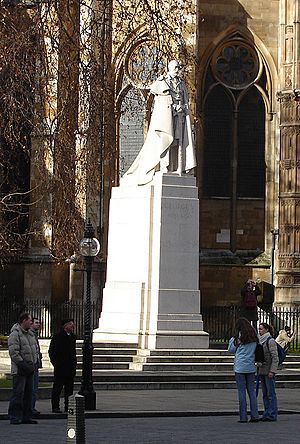William Reid Dick facts for kids
Quick facts for kids
William Reid Dick
|
|
|---|---|

Portrait of William Reid Dick, 1934, by Philippe Ledoux
|
|
| Born | 13 January 1878 Glasgow, Scotland
|
| Died | 1 October 1961 (aged 83) Maida Vale, London, England
|
| Alma mater |
|
| Known for | Sculpture |
Sir William Reid Dick (born January 13, 1878 – died October 1, 1961) was a famous Scottish sculptor. He was known for his unique way of shaping monuments and for keeping his portraits simple. He became a member of the Royal Academy in 1921 and a full Royal Academician in 1928.
From 1933 to 1938, Dick led the Royal Society of British Sculptors. King George V made him a knight in 1935. He also served as the official sculptor for Scotland to King George VI from 1938 to 1952. After that, he continued in the role for Queen Elizabeth until he passed away in 1961.
Contents
Life of a Sculptor: William Reid Dick
Early Years and Learning
William Reid Dick was born in Gorbals, a working-class area of Glasgow, Scotland. When he was just twelve years old, he started an apprenticeship with a company that carved stone. For the next five years, he learned how to carve stone. At the same time, he took evening classes at the Glasgow School of Art.
In 1892, he helped carve parts of the Kelvingrove Art Gallery under the guidance of George Frampton. He finished his apprenticeship in 1896. From 1904 to 1907, Dick went back to the Glasgow School of Art. He took both day and evening classes in drawing and sculpture.
After graduating in 1907, he taught at Bellshill Academy. But in 1908, he moved to London. There, he took evening classes at the South London Technical School of Art. He also worked as an assistant for another sculptor, Edwin Whitney-Smith. In 1908, his work was shown for the first time at the Royal Academy in London. He gained more fame in 1911 with a marble statue of Harry Lauder, which was also shown at the Royal Academy.
In 1914, Dick married Catherine Emma Treadwell. They had three children together. They lived in the St John's Wood area of London. In 1938, they bought a large house and studio in Maida Vale, where they lived for the rest of their lives.
Serving in World War I
In September 1914, William Reid Dick joined the Territorial Army. From 1915 to 1919, he served with the Royal Engineers in both France and Palestine. He first joined the 5th London Field Ambulance section. Later, he moved to the 3rd Army Field Survey Co. and then the 7th Field Survey Co. He was listed as a photographer with the 7th Field Survey Co. His army records show his job as "sculptor." He received several medals for his service. While in northern France, Dick even made small statues using local clay.
Becoming a Famous Sculptor
After the war, Dick designed several important war memorials. These included memorials in Bushey and Rickmansworth. He also created the eagle sculpture on top of the Royal Air Force Memorial in London. He received a big project to design the Kitchener Memorial Chapel (1922–25) in St Paul's Cathedral, London. The main part of this design was a sculpture called a Pièta. This sculpture won a gold medal at an international exhibition in Paris in 1925.
These works made him very well-known. He was elected to the Royal Academy in 1928. In 1935, Dick was made a Knight. He also became the President of the Royal Society of British Sculptors, a role he held until 1938.
From 1938 to 1952, Dick was the King's Sculptor in Ordinary for Scotland. This meant he was the official sculptor for the King in Scotland. After King George VI, he continued this role for Queen Elizabeth until he died. He attended many royal events. He created several portraits and memorials for members of the Royal Family. He also made statues of important political and artistic people of his time.
Besides his large public monuments, Dick also sculpted smaller busts and statues. He regularly showed these at the Royal Academy and other art galleries in Scotland and Paris. He was elected to the Royal Scottish Academy in 1939. Throughout his career, Dick was part of many important committees. These included the Royal Fine Art Commission and the Board of Trustees of the Tate Gallery.
William Reid Dick passed away at his home in Maida Vale. He was cremated at Golders Green crematorium. In October 1963, a special memorial tablet for him was placed in the crypt of St Paul's Cathedral. His old papers and artworks are kept at the Tate Gallery.
Images for kids




























